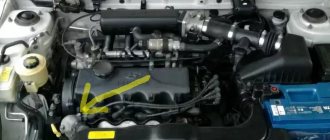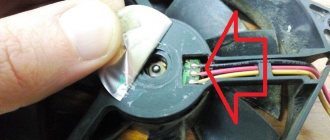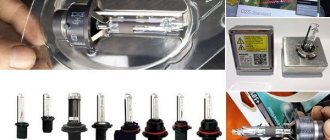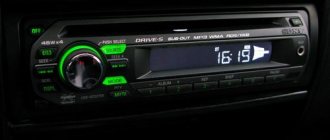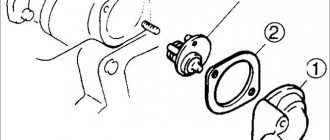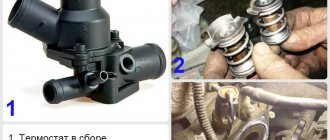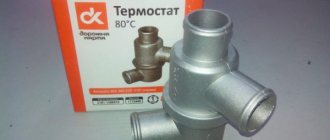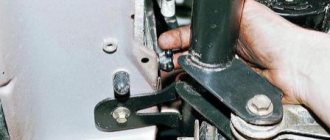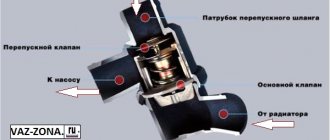The thermostat is a key component in the cooling system. It is responsible for high-quality warming up of the engine due to the fact that the flow of antifreeze will be redirected in a timely manner in small and large circles.
But as soon as the thermostat fails, the internal combustion engine begins to overheat or, conversely, it is difficult to reach the required temperature. To avoid negative consequences, the driver should know how to check the thermostat.
After starting the internal combustion engine, the thermostat should be closed, the circulation of antifreeze will be carried out in a small circle, this will help to quickly warm up the engine. As soon as the antifreeze reaches certain temperatures, a special valve opens inside the thermostat, then circulation begins to occur in a large circle. Each car has its own opening temperature. When the thermostat stops functioning, this becomes one of the reasons for the engine overheating or the reason for warming up for too long.
You should always monitor the functionality of the thermostat. Every motorist can carry out the check, and it is not at all necessary to resort to the help of specialists. In this case, there is not even any need to remove the thermostat from the car. To do this you need the following:
- We start the car engine and wait until the antifreeze heats up to a certain degree, when the thermostat operates. After the antifreeze heats up, the driver needs to touch the two pipes with his hands. The first, or rather the upper one, is responsible for the supply of liquid, and the lower one for the supply.
- Once the temperature reaches 70 degrees, the bottom pipe should be cool. However, as soon as the temperature rises to 90-95, the thermostat starts working and the pipe instantly becomes hot. If the device displays a temperature that exceeds 100 degrees, but the pipe still remains cool, this indicates a problem with the thermostat. Then the internal combustion engine will seriously overheat.
- When the heating of the lower pipe occurs smoothly, and the temperatures of both pipes are approximately the same. This means that the thermostat is always open. In fact, this is also a kind of malfunction. After all, this is due to the fact that the internal combustion engine will heat up much more slowly.
This is interesting: How much time do you have to refuel your car after the low fuel light comes on?
The thermostat cannot be repaired. The only way out of the situation is replacement. Thanks to these methods, you can easily check your thermostat without a professional.
This is interesting: A simple method that can help get rid of air in the cooling system Excellent article 0
Basic thermostat malfunctions
The thermostat is a fairly simple device that rarely fails. If you have problems with your thermostat, they are most often associated with the following reasons:
- The valve for switching the liquid circulation from a large to a small circle has stopped closing tightly. Because of this, immediately after starting the engine, antifreeze circulates in a complete large circle, which is why warming up to an operating temperature of 90 degrees Celsius takes many times longer than with a working thermostat;
- The fluid circulation switch valve is stuck closed. In such a situation, the sensor to open it is triggered, but the damper cannot move. This leads to the fact that the antifreeze continues to circulate in a small circle even after the engine has warmed up. Accordingly, the engine parts do not receive the necessary cooling, and it overheats.
We recommend: The windshield washer does not work: we look for the cause and eliminate it
The thermostat is not expensive, but it is not to blame for all problems with engine cooling. That is why, before replacing the thermostat, you need to make sure that it is faulty.
What does a car thermostat do?
Like any other water-cooled engine on a passenger vehicle, the engine in your car operates in a temperature range of approximately 195–220 °F (91–104 °C) . To help it operate within this range, your car's engine uses a thermostat.
Simply put, the thermostat responds to changes in temperature—in this case, coolant temperature—by opening or closing a valve to control the flow of coolant between the radiator and the engine. The valve itself operates through a wax container element. So it is small, simple and effective. The expansion element container in the thermostat faces and is in contact with the engine coolant. As the coolant temperature rises, the liquid in the container begins to melt and expand, pushing a small rod that separates the center plate from the surrounding mounting base to open the valve.
About the operating principle of the thermostat
The part is a heat-sensitive element that opens the damper when heated to a certain temperature (from 87 to 93 ° C). The actuator is triggered by the expansion of the working fluid - a special liquid that responds to changes in ambient temperature (in this case, antifreeze).
The thermostat with a hermetically sealed damper is usually placed in its own housing and is a separate part. But there are also open-frame products that are installed inside a designated channel in the engine. The operating algorithm is the same for all models:
- After starting a cold engine, the coolant flows in a small circle - through the water jacket of the power unit and the small heat exchanger of the stove. The passage to the main radiator is blocked by a damper, which speeds up engine warming up.
- When the set temperature threshold is reached, the damper begins to open, allowing part of the antifreeze to cool in the main radiator.
- When the engine warms up to operating temperature (over 90 °C), the passage opens completely and all the antifreeze moves along a large circulation circuit.
Primary signs of a thermostat malfunction come down to two symptoms: constant “boiling” or the inability to warm up the power unit, especially in winter.
Symptoms and causes of malfunction
There are 3 types of failure of the temperature-sensitive element:
- the antifreeze passage to the main radiator does not open when heated;
- the damper is stuck in the half-closed position;
- the same, in a fully open state.
Note. These problems arise for two reasons: natural wear or low quality coolant, which produces deposits on the internal walls of pipes and system parts. A similar effect is achieved by pouring distilled and plain water.
In the first case, heated antifreeze cannot enter the main radiator and is cooled only in the cabin heater. As a result, the engine begins to overheat and the liquid begins to boil in the expansion tank. The malfunction is accompanied by the release of steam from the plug valve, a quiet hiss and critical thermometer readings on the instrument panel.
The most difficult time to determine a thermostat malfunction is when the damper has partially opened and is stuck in this position. A cold engine warms up sluggishly, and in operating mode the electric fan often turns on, forcing the radiator to cool. The problem is clearly identified during the summer heat, when half of the antifreeze circulates through a small circuit. The electric fan practically does not turn off, although overheating is not observed.
Important! Identical symptoms with an increase in temperature can be caused by another reason - the formation of an air lock in the car’s cooling system. Therefore, the thermostat must be carefully checked before replacement.
In the third case, the engine heats up to operating temperature only in the summer, since the antifreeze constantly moves in a large circle and is effectively cooled by the radiator. It is impossible to drive in winter - the stove does not heat at all.
How to check a car's thermostat
There are two main ways to check a car's thermostat. One of them is carried out without removing the part, but requires a pyrometer, and the second is simpler, but the element will need to be removed from the engine during the test.
Checking the thermostat without removing it from the engine
As you know, the thermostat housing is connected to the upper radiator hose, which is included in a large circle of coolant circulation. Accordingly, with the thermostat working, after starting the engine, the upper radiator hose should remain cold (slightly warm) for some time until antifreeze is released through it.
To check the thermostat without removing it from the engine, get a pyrometer (temperature measuring device). You may come across the opinion that the check should be done without a device, measuring the temperature with your hands, but this is quite dangerous, given the large number of moving parts when the engine is running.
We recommend: How to replace a VAZ-2114 pump with your own hands
Point the pyrometer at the upper radiator hose and start the engine (cold start). For two or three minus periods, observe the device’s indicators. Next, draw a conclusion about the serviceability of the thermostat according to the following rules:
- The hose was cold for two or three minutes (or its temperature rose slightly), and then quickly warmed up. This indicates that the thermostat is working properly, and it switched the coolant circulation from a small circle to a large circle after the engine has sufficiently warmed up;
- The hose initially warmed up slowly. In this case, we can say that the thermostat is stuck in the open position and the antifreeze does not circulate in a small circle;
- The hose did not begin to warm up quickly after two or three minutes. That is, the thermostat is faulty and it does not switch the coolant circulation from a small circle to a large one.
Important: While checking the thermostat, monitor the engine temperature on the instrument panel. If the thermostat is stuck and won't keep the coolant flowing, the engine will start to overheat, which can lead to expensive parts failure.
Checking the thermostat in the pan
A widespread and well-known way to test the thermostat yourself is using a saucepan. As you might guess, before diagnostics you will need to remove the thermostat from the car engine and bring it home. After this, do the following:
- Take a pot and fill it with water;
- Inspect the thermostat housing and read the technical information on it, which indicates at what temperature it should switch;
- Hang the thermostat in the pan so that it is immersed in water, but does not touch the walls and bottom of the container, that is, it comes into contact only with water;
- Start heating the water and put a regular thermometer in it to measure the temperature of the liquid;
- When the water approaches the thermostat switching value from closed to open, make sure this happens. Also compare the thermometer reading, recording the temperature at which the coolant circuit switching valve opens with the ideal values indicated on the device body.
If the valve opens when heating water, track its behavior when cooling the liquid, checking at what temperature it returns to its original position. Based on the data obtained, draw a conclusion about the functionality of the thermostat.
How to understand that the thermostat is not working
Now that you have an idea of how a thermostat works, you can use this knowledge to investigate the problem.
- First, open the hood and make sure the engine and radiator are cold.
- Next, find the thermostat. If you follow the upper radiator hose towards the engine, you will see the end of this hose connecting to the body of this valve. It is located inside this building. However, on some car models, its housing is connected to the lower radiator hose.
- If you need help locating this device, consult your vehicle's service manual. You can buy one at your local auto parts store or online. You can also order it online via the Internet.
- Once you have located the thermostat, perform one of two simple tests: If you have access to the radiator cap on your vehicle, use the following troubleshooting procedure: Check Coolant Flow. If the radiator cap is inaccessible or the cap is not visible, proceed to the following troubleshooting procedure: Checking the coolant temperature.
Some recommendations before starting work:
Even if your radiator cap is accessible, you can actually perform both tests since neither requires removing the thermostat from the car, and they both only take a few minutes.
If the engine overheats, it is recommended to have someone at the wheel to turn off the engine if the temperature reaches dangerous levels during testing.
If any of your tests indicate a faulty thermostat, follow the third procedure below, How to Test a Car Thermostat, to test it outside the car and see if you need to replace it.
If you're performing one of these tests because your engine is overheating, it's a good idea to have someone behind the wheel to turn off the engine if the temperature reaches unsafe levels during the test.
Ways to check an element
You can check the operation of the thermostat yourself directly in the car. In the vast majority of cases, such diagnostics give reliable results. You need to start checking when the engine has completely cooled down: start it and periodically feel the lower part of the radiator and the pipe extending from the bottom back to the engine.
The serviceability of the thermostat is determined by the following signs:
- at the initial stage of warming up, the radiator and the pipes suitable for it are completely cold;
- at an antifreeze temperature of 40–60 °C, the upper supply hose begins to warm up, the lower one remains cold;
- when the antifreeze heats up to 90–95 °C, the entire area of the heat exchanger and the lower pipe become hot, which indicates the opening of the damper and the movement of liquid along a large circuit.
It is recommended to carry out diagnostics until the sensor is triggered and the fan automatically turns on.
Deviations from the norm are interpreted as follows:
- If the inlet and outlet pipes together with the radiator immediately warm up, the thermostat is stuck in the open position. Antifreeze initially flows in a large circle, hence the heating.
- When the temperature reaches 90 °C, the bottom of the heat exchanger and the outgoing hose remain cold - the thermoelement damper is tightly closed, the part has become unusable.
- When the top of the radiator is hot and the bottom is slightly warm, the thermostat is stuck half-closed.
Unlike the first two points, the last conclusion requires mandatory confirmation. It is quite difficult to make a clear diagnosis when the coolant is divided into two streams moving along different circuits. Uneven heating of the heat exchanger fins, turning on of the fan and temperature surges are indirect signs. Symptoms of an air lock in the cooling system appear similarly.
To clearly check the functionality of the thermostat, it will have to be removed from the car. Disassembly and diagnostics are performed in the following order:
- Let the engine cool and drain the antifreeze - first from the cylinder block, then from the radiator. It is more convenient to empty the system into a wide container with low sides.
- Loosen the clamps securing the pipes to the thermostat. Disable them and remove the element.
- Inspect the part for a slightly open damper. If a malfunction is detected, further checking is pointless - you need to buy and install a new spare part.
- Heat a pan of water on the stove. When its temperature approaches boiling, lower the thermostat into the container and watch the damper. It should open without delay.
- Remove the part from the pan. When cooled, the thermoelement should immediately close the passage.
Reminder. After draining the cooling system, immediately disconnect the throttle body heating pipe. When you start pouring antifreeze back in, air will escape through the removed hose.
If during the inspection it turns out that the damper does not work or is jammed, the part must be replaced, since it cannot be repaired. Considering the large number of fakes on the auto parts market, you can first test a new thermostat in a store. Close the outlet pipe with your finger and try to blow air through the inlet pipe. A hermetically sealed damper will prevent this from happening.
Retest the new part at home by immersing it in a pan of boiling water. If the heat-sensitive mechanism does not work, return the defective part to the store or exchange it for another one.
Examination
After starting the engine, the still cold coolant begins to circulate in a small circle (circuit), which includes the stove (heating radiator) and the engine itself. This is necessary so that the engine reaches operating temperature faster. After reaching this mode, the thermostat valve opens - initially it is closed and the coolant also begins to circulate through the engine cooling radiator. Knowing these principles will tell you how to check your thermostat.
We recommend: Determining the signs and causes of wheel bearing failure
Without taking off
The easiest and most affordable way to check the functionality of the thermostat is to carry out a test directly on the car, without needing to remove it. The condition is that the engine is cold at the start of the test. The check begins by starting the engine. After this, you need to wait one and a half to two minutes for the engine to idle. Usually during this time the engine has not yet had time to warm up to operating temperature, and the coolant must circulate in a small circle (circuit).
Therefore, the engine cooling radiator should not be activated yet. To verify this, touch the rubber pipe fitting to the top of the radiator with your hand. If it is relatively cold, then the coolant is currently circulating only through the stove and engine. Therefore, the thermostat valve is in the closed position, as it should be.
After waiting some more time, and for greater persuasiveness, waiting until the temperature sensor needle shows 90 degrees Celsius, we again touch the inlet pipe of the engine radiator. The valve should already be open at this time, and thus hot coolant should flow into the radiator. The pipe will therefore be hot in this case. The lower pipe coming from the radiator should also be hot. If this does not happen, then we can conclude that the valve remained closed, that is, for some reason it was jammed. In this case, the thermostat must be urgently replaced to avoid engine overheating.
And of course, it is clear that if almost immediately after starting the engine the inlet pipe of the cooling radiator begins to heat up slowly, this indicates that the valve is stuck in the open position and the coolant is constantly circulating through a large circuit.
In this case, the engine operates at a low temperature, since it is difficult for it to reach the optimal temperature regime. This situation is not as critical as when the valve is constantly closed, but it is unpleasant due to increased fuel consumption.
It is also possible for the valve to jam in some intermediate state, between the open and closed positions. In this case, the engine will take longer to warm up and reach operating temperature. Such a malfunction is more difficult to determine, but it is also possible. How to check the serviceability of the thermostat in this case? To do this, you will have to remove it from the car.
To do this, first of all, you need to drain the coolant. It should be drained carefully to avoid possible contamination. This will allow it to be reused. To drain the coolant, you can use any container of the required size (every car enthusiast can find out the coolant volume of his car from the technical documentation for the car).
The container is placed under the drain plugs, after which they are unscrewed. In this case, it is necessary to unscrew the cap of the expansion tank to better drain the coolant. You can also find out where the coolant drain plugs are located from the technical documentation for the machine. Some car models do not have such plugs. In this case, it is necessary to place a container for draining the coolant under the lower pipe of the engine radiator.
After this, the clamp securing the pipe to the radiator is loosened, the pipe is removed, and the coolant is drained into a prepared container. Draining the coolant, and thereby avoiding its loss, you can remove the thermostat. This usually doesn't cause problems. The pipe(s) coming from it are also removed and it is unscrewed using the appropriate wrenches and a screwdriver.
We recommend: What kind of fluid is poured into the power steering
After removal
After these operations we go to the kitchen. The verification method is very simple, wireless. There is no need to connect any devices. Home conditions are the most suitable. Place the thermostat in a saucepan or other metal container, fill it completely with water and place it on the fire. In this case, it is necessary to create such conditions so that its body does not touch the walls of the pan. You should also have a technical thermometer that can measure temperatures of at least 100 degrees Celsius.
We carefully monitor the thermometer readings and the condition of the valve. When the temperature indicated on the thermostat is reached, its valve should open. This action is achieved thanks to artificial wax, which is the working substance of the valve. When heated, the wax expands significantly in volume, activating the valve.
We make sure that the valve opened exactly at the specified temperature. If tearing does not occur, then the thermostat is inoperative. Then we take it out of the water and let it cool. When it cools down, the valve closes. If we do not observe this, then it must also be replaced. We hope that this information will be useful and help solve any problems that may arise.
How to replace a bad thermostat
Car thermostat problems can be diagnosed with these simple troubleshooting procedures. They only take a few minutes and will help you find the cause of your unusual engine operating temperature.
What's more, they'll help you keep your engine—and your wallet—from damage and emptiness. If your troubleshooting procedures indicate that the thermostat is working, find the cause of the problem as soon as possible. In this case, a car repair manual for a specific make and model of car will be of great help, or contact a good car service station to identify the reasons for the engine overheating or, conversely, the engine being unable to reach operating temperature.
